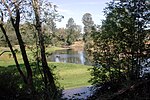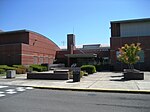Molalla River State Park
Clackamas County, Oregon geography stubsParks in Clackamas County, OregonState parks of Oregon

The Molalla River State Park is located in U.S. state of Oregon. It is a few miles north of Canby, and half a mile from the Canby Ferry. The park is south of the Willamette River and east of the Molalla River, at the confluence of the Pudding, Molalla and Willamette rivers. The Pudding River flows into the Molalla from the west, just before the Molalla joins the Willamette. The floodplains of these rivers provide important habitat for waterfowl, wading birds, deer, small mammals, reptiles and amphibians. A blue heron rookery, one of the largest in the Willamette Valley, is located in Molalla River State Park.
Excerpt from the Wikipedia article Molalla River State Park (License: CC BY-SA 3.0, Authors, Images).Molalla River State Park
Riverside Trail,
Geographical coordinates (GPS) Address Nearby Places Show on map
Geographical coordinates (GPS)
| Latitude | Longitude |
|---|---|
| N 45.2956758 ° | E -122.7025931 ° |
Address
Riverside Trail
Riverside Trail
97013
Oregon, United States
Open on Google Maps








